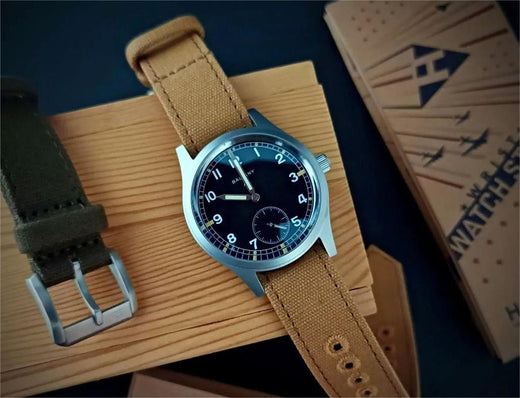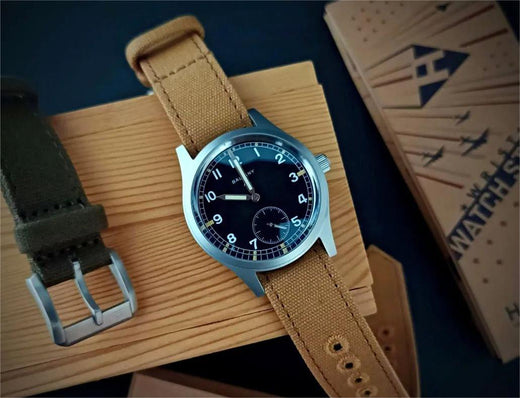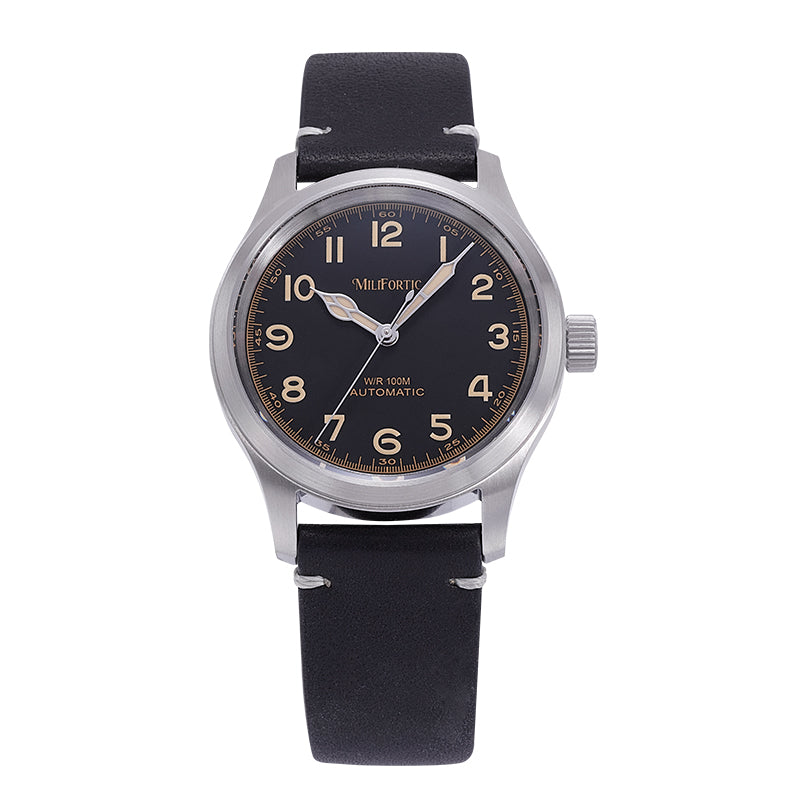
Indeed, among various types of timepieces, field watches may seem the least self-explanatory at first glance.
Unlike dive watches or polit watches, the term "field watch" does not immediately convey its purpose. One might assume it simply refers to any durable timekeeper suitable for farming or activities involving magnetic fields.
However, reality is more deeply rooted in history. The origins of field watches serve a specific purpose: they were designed for military use during World War II. "Field" refers to the harsh environments in which soldiers carried out missions. These timepieces were meticulously crafted to withstand the rigors of the battlefield, with designs prioritizing durability, legibility, and functionality.
Beyond Field Watches
Field watches typically feature simple, clean dials, large numerals, and luminous hands to ensure visibility in low light conditions, serving as crucial tools for soldiers to coordinate maneuvers and track time during missions. Their purpose is to create a reliable, legible timepiece capable of withstanding the rigorous tests of active service.
Fast forward to today, field watches have transcended their military origins. They have become an enduring style that surpasses their initial purpose. Modern field watches retain the simple, durable, and practical designs of their wartime predecessors. They are appreciated for their versatility, suitable for everyday wear, outdoor adventures, and various activities.
Essentially, the field watch category has evolved from its military roots into a symbol of classic, understated style, favored by those who appreciate the fusion of horological function and aesthetics. Understanding the historical background of field watches enriches people's understanding of their enduring appeal in the contemporary watch world.
The Origin of Field Watches
The emergence of field watches was not the result of fashion trends or groundbreaking technological advancements; its origins can be traced back to the evolution of wristwatches during this tumultuous period.
In the early 20th century, as warfare shifted to the trenches, strapping watches to the wrist became a practical solution. Wearing watches on the wrist allowed soldiers to easily check the time and free up their hands during combat. However, the initial wristwatches were essentially modified pocket watches, often lacking the durability required by active-duty troops.
As time passed and lessons were learned from World War I, men's wristwatches underwent significant development. The design and structure of watches were continuously improved to better meet the wearer's needs, especially in military environments. As World War II loomed, armed forces were better prepared and equipped with specialized wristwatches.
Field watches were born out of this development process, becoming dedicated timepieces designed to endure harsh combat conditions. These watches were not an afterthought or a makeshift solution but were specifically designed for military personnel: durable, clear, and practical. They represented a deliberate and planned evolution from the makeshift watches of World War I.
Essentially, field watches reflect the lessons learned from early military timing challenges. Their design is a deliberate and strategic response to the shortcomings of early wristwatches, creating a specialized timepiece that has since become a symbol of classic, practical style.

Some Classic Field Watches
ATP Watches
During the outbreak of World War II, the British Ministry of Defence entered into a contract with 17 Swiss watchmakers to produce a series of watches known as the ATP (Army Trade Pattern) series. This collaboration aimed to provide military personnel with watches specifically designed to meet the demands of wartime conditions.
ATP watches featured a 31mm "waterproof" case, emphasizing durability and resilience. The white dial adorned with luminous hour markers and hands ensured readability even in low-light environments—a crucial aspect of military operations. The addition of a small seconds sub-dial enhanced the practicality of these timepieces.
A significant requirement for ATP watches was their accuracy, with a daily error tolerance of within +/-30 seconds. This specification aimed to ensure reliable timekeeping for military personnel in the field.
An interesting historical twist is that the Swiss factories producing these watches, in order to maintain neutrality, also produced black-dial versions for the German military. This illustrates the complex dynamics of the watchmaking industry during times of conflict and the intricacies of maintaining neutrality in a global war.
The ATP series witnessed collaboration between the British Ministry of Defence and Swiss watchmakers during a period of historical upheaval. These watches, with their specific functionalities and historical background, remain notable artifacts, highlighting the intersection of horology and wartime necessities.

A11 Watches
In 1941, the United States entered World War II, necessitating wristwatches that could meet specific military requirements. In response to this need, the A-11 watch was developed and manufactured by American watch companies such as Elgin, Waltham, Bulova, and others. While these watches were not as standardized as their British ATP counterparts, they were designed with certain key functionalities to meet the needs of soldiers and pilots.
An important requirement of the A-11 watch was the inclusion of a hacking feature in the movement. Hacking refers to the ability of the movement to stop the seconds hand when the crown is pulled out. This feature was crucial for missions, allowing soldiers and pilots to easily synchronize their watches. The ability to accurately coordinate time was essential for various military operations, ensuring precise and efficient execution of missions. The introduction of the hacking feature in the A-11 watch represented a thoughtful innovation that contributed to the success of military operations.
The A-11 watch played a crucial role during the war, providing reliable and synchronized timekeeping for American military personnel. While their appearance was less standardized compared to ATP watches, the emphasis on the hacking feature demonstrated a commitment to practical functionalities in this field.
The American A-11 is often hailed as the "watch that won the war," serving as not only historical artifacts but also evidence of watchmakers' adaptability and ingenuity during times of conflict.
The Dirty Dozen Watches
One of the most iconic designs of field watches emerged towards the end of World War II. In 1945, the British military introduced a new set of specifications to improve upon the ATP design, giving rise to the now well-known "Dirty Dozen." This name pays homage to the 1967 movie and the 12 Swiss companies commissioned to manufacture these historic timepieces.
The Dirty Dozen watches feature black dials, a carefully considered choice aimed at reducing glare and enhancing overall visibility in various lighting conditions. This design consideration was crucial for military personnel engaged in combat in different environments. Additionally, the watches bear the Broad Arrow symbol associated with the Ministry of Defence, also known as the "Pheon" or "Crow's Foot" symbol. This symbol became a unique marker of authenticity and military heritage.
Today, the Broad Arrow symbol commonly appears in modern versions of Dirty Dozen watches, expressing their historical significance. Retro-style field watches following in the footsteps of the Dirty Dozen often draw inspiration from their classic design elements.

A17 Watches
After the end of World War II in 1945, the United States became involved in the Korean War in 1950. This conflict led to the introduction of a new specification of watches called the A-17, which was utilized by both the Army and the Air Force. The most notable feature of the A-17 is its smaller numeral ring, facilitating quick conversion to 24-hour military time, which is a crucial function for military personnel.
Over the subsequent decades, the style of the A-17 underwent various changes, and by the time of the Vietnam War, a standardized field watch design emerged. This design featured triangular hour markers, becoming a defining aesthetic element of military-style timepieces.
Some Outstanding Field Watches Today
For enthusiasts seeking watches with timeless military aesthetics, vintage-style field watches often resonate with the look and feel of the Dirty Dozen. These watches feature black dials and symbolic markings, paying homage to key moments in watchmaking history while also becoming enduring symbols of military-inspired design.
The Hamilton Khaki Field collection is renowned for its popularity, especially the Khaki Field Mechanical, which is one of the most sought-after field watches currently available. Influenced by the iconic triangular hour markers, particularly those used during the Vietnam War, the Hamilton Khaki Field series retains these markers, often accompanied by a 24-hour scale bezel, staying true to military-style design.
For those seeking more affordable options, there are several choices available on the market. The mechanical Seiko 5 Sports Field, the vibrant RZE Valor 38, and the quartz-powered Timex Expedition series are notable examples. These watches offer affordability without compromising on the classic aesthetics of field watches, making them convenient choices for a wide range of enthusiasts.
Baltany watch offers a range of highly acclaimed field watches, with its white 39mm version staying faithful to the early ATP watch design. Meanwhile, the khaki field watches, with their refined appearance, feature a more modern style of design and come with a calendar function. The diverse range of sizes and movements offered by Baltany is also a significant factor in winning over more customers.
Design Characteristics of Modern Field Watches
Beyond their military origins, the modern definition of field watches has greatly expanded, encompassing a variety of designs. While some contemporary field watches may share similarities with mainstream military timepieces, variations in case shape, dial fonts, and overall aesthetics are common. The unifying factors typically lie in their robust design, waterproof capabilities, and commitment to simplicity and readability.
The case shapes of modern field watches may vary significantly, allowing for creativity and diversity in design. Key standards often revolve around the watch's ability to withstand complete immersion, making waterproofing a critical feature. This ensures that the watch maintains functionality and reliability in various outdoor environments and activities.
A concise dial layout is another hallmark of modern field watches, emphasizing readability. This often involves large, clear numerals, contrasting hands, and tidy designs prioritizing quick time-telling at a glance. The application of luminescent materials for solid luminosity further enhances visibility in low-light conditions, contributing to the practicality of the watch.
In conclusion, contemporary field watches have transcended their military roots, encompassing a broader range of designs. Emphasis on durability, waterproofing, simplicity, and readability remains at the core of these watches, making them versatile companions for outdoor enthusiasts and everyday wear. Modern field watches represent a fusion of tradition and innovation, catering to a variety of tastes and preferences in the watch world.
Read more:
Learn More About GMT Auto Watches With Microbrand Watch SCMT
More watches info by Youtube:
What Is A Field Watch? Top 5 Field Watches Of All Time! (Rolex, Seiko, Boldr, Hamilton, Orient)
Field Watches: Everything You Need To Know!
The BEST Field Watches - Affordable to Luxury



0 comments